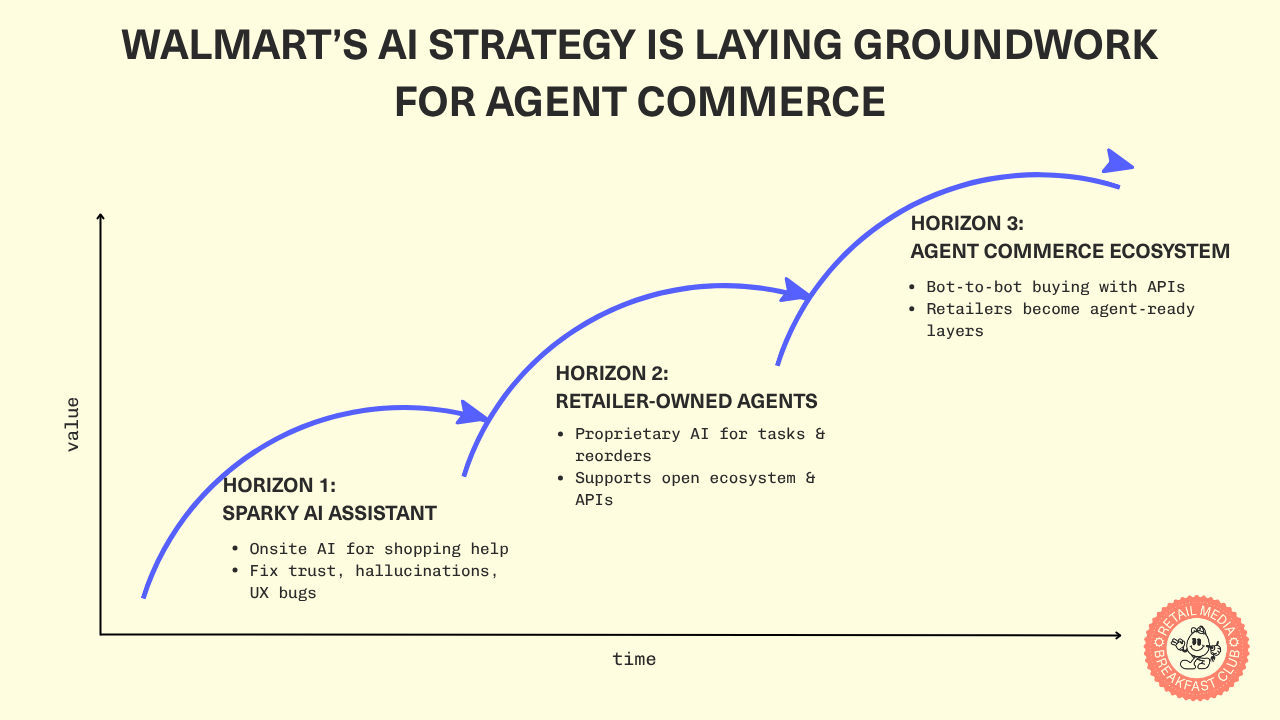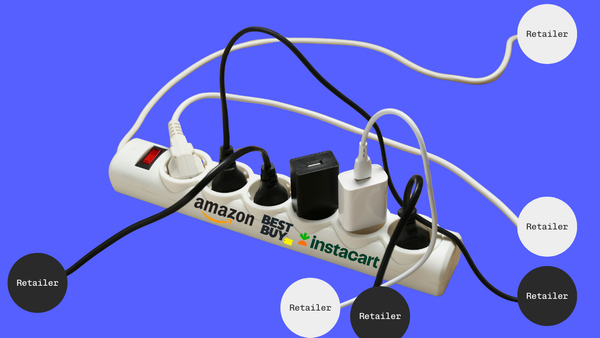Walmart's Sparky AI Assistant: A Late Mover with Early Promise
I remain convinced that shoppers will increasingly turn to their own personal AI assistants for help interacting with retailers, rather than relying on retailer AI assistants who always going to be limited by context from their own walled garden.

Walmart's Sparky AI shopping assistant is a fairly late mover in the AI shopping space. Amazon and Instacart were very early, and now there's a whole bunch of AI assistants available, whether or not consumers actually like interacting with them.
But while Sparky may be playing catch-up, it's already revealing something about the future of conversational commerce—and what brands need to do to stay visible in this new landscape.
Current State: Not Ready for Prime Time
Sparky feels like it's still finding its place (literally). You can find it within search results and on product detail pages on mobile, though Walmart says you'll soon be able to access it by clicking on the smiley face in the middle of the bottom navigation bar.
In fact, in the process of writing this post today, my UI literally just changed from having Sparky buried in search results and on the PDP, to now showing up in my navigation bar!
Today I threw Sparky a combination of product-specific questions (questions about how specific haircare products work and their ingredients), and research type questions (what supplies do I need for a unicorn-themed party? What are the benefits of low-toxin coffee? )
Some accuracy and usability issues I noticed:
- Sparky calls out seller ratings rather than product ratings by default when I ask for 'ratings'
- When I asked for toys priced "between 40 and 50" and got products under $20.
- It does not reliably pull fulfillment info on third-party items, though it can tell me which items are available for pickup in-store.
What's Working: The Conversational Promise
Despite these early issues, Sparky is actually quite conversational—when I asked about low-toxin coffee, it asked what type I wanted: beans, ground, etc. As Carter Jensen, Senior Manager of Enterprise Marketing Capabilities at General Mills, also observed, Sparky remembers context, maintaining conversation threads even after other interactions.
According to Joe Murphy, Founder of Shelfsight, technical analysis reveals that Sparky can access information such as a user's login status and browsing history. However, Sparky currently doesn't appear to actually understand prior purchase history, limiting its ability to answer personalized questions and be truly helpful.
A Key Differentiator: Transparency Through Sources
One element that sets Sparky apart is its approach to citing sources—something unique among AI shopping assistants. In the Sparky interface, Walmart explicitly notes "this response uses information within Walmart.com and customer reviews."
For more conversational advice-type responses, it shares external sources. This transparency could be a massive trust-builder since consumers know where the info is coming from. When shoppers can see that Sparky is pulling from actual customer reviews and product specifications rather than "making stuff up," it directly addresses the core trust issue that's plaguing AI assistants.
The Future: Walmart's Unique Moat
But this is the worst Sparky will ever be, right? Walmart has a significant moat that other retailers can't match: in-store availability and reach. Imagine Sparky truly understanding your in-store buying habits and becoming a smart assistant that remembers your preferences.
The vision becomes compelling: As Carter Jensen pointed out - imagine Sparky creating your shopping cart on a Sunday night with things you need and inspiration for new purchases. It could order third-party items and create a list of things to pick up in-store.
Even more powerful would be integration with Walmart's value-added services—auto services, custom cakes, vision center, assembly services, and subscription management.
I do remain convinced, however, that shoppers will increasingly turn to their own personal AI assistants for help interacting with retailers, rather than relying on retailer AI assistants who always going to be limited by context from their own walled garden. As I wrote last week following news that Walmart is preparing for AI shopping agents, the retailer is taking a fundamentally different approach than Amazon. While Amazon builds a 'walled garden' of proprietary AI tools, Walmart is preparing for an open ecosystem where third-party agents can interact with their systems. Sparky could evolve from a shopping assistant into the foundation for agent-to-agent commerce.

AI Shoppers Don't Scroll
With AI agents, we're moving toward a world where maybe only 3-5 products get "recommended" for any given query. It's like having a personal shopper who only shows you their top picks - which means brands that don't make it into the AI's consideration set become essentially invisible.
AI shoppers don't scroll—if you're not optimized for AI, you're invisible.
The onus is on brands to develop enough content and context across many channels that we know AI assistants and LLMs are crawling: PR, Reddit, customer reviews, and a brand's DTC website. All become high-fidelity sources for retailers.
The Trust Gap With AI Assistants
The trust gap creates both challenge and opportunity. Sparky's approach to citing sources—showing consumers exactly where information comes from—directly addresses the skepticism 55% of consumers feel toward AI shopping tools.
If Walmart can fix the accuracy issues while maintaining this transparency, they could differentiate in a crowded field.
But the real winners will be brands that prepare for this AI-driven future. Whether shoppers use Sparky, ChatGPT, or future AI agents, the same principle applies: if you're not optimized for AI discovery, you're invisible. Complete product information, genuine customer reviews, and clear value propositions aren't just good marketing—they're survival essentials in a world where AI curates our choices.





